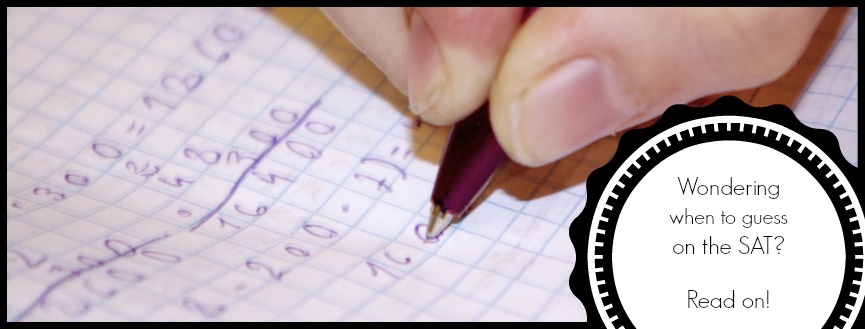Disclaimer: This article is for the 2005 SAT. Click here to learn about the new, 2016 SAT.
Let me paint you a picture. You’re in the midst of taking the SAT and you’re on a roll. You’re breezin’ through the questions one by one (because you studied so hard!), when suddenly you encounter a question and… *gasp*…you don’t know the answer!
What do you do?
On any other test , you’d take a guess and hope you guess right. Unfortunately, the SAT isn’t that simple.
Most of you have probably heard about the SAT guessing penalty, but for those of you that haven’t, you should know this:
- you will lose a quarter of a point for each question you answer incorrectly
- if you don’t answer the question you will receive 0 points.
The guessing penalty can be scary and, as a result, many students tend to skip questions even if they’re slightly unsure about the answer.
What these students don’t know is that, even if you’re not entirely sure of the answer to a question, there are techniques you can use to make sure you’re still safely guessing.
How can this be possible? Read on and find out how guessing can work to your benefit!
What is your target score?
Before I start talking about SAT guessing strategies, you should think about what score you’re aiming for on each section of the SAT.
The higher the score you’re aiming for, the fewer questions you can leave blank.
The pacing chart below shows approximately how many questions you can afford to leave blank in a section of the test—Writing, Critical Reading, or Math—based on your target score.
If you’re aiming high, you’re really going to want to learn these next few guessing strategies. If you guess correctly, you can achieve your target score!
Eliminating answer choices
If you read the answer choices to a question and have no idea which answer choice is the correct one, you should probably just leave that question blank…
…but if you can eliminate even just one answer choice, you should technically guess!
Think about it!
If you eliminate 1 of the 5 answer choices, you’re left with 4 answer choices to pick from; so, you have a 1 in 4 chance of answering correctly.
Let’s say you can eliminate 1 answer choice on 4 different questions, and pick answer choices randomly from the remaining choices.
Statistically speaking, you should answer at least 1 of these questions correctly.
Your net score after guessing on these 4 questions is 1 – ¼ – ¼ – ¼ = ¼. A quarter of a point!
However, many test takers are often biased, and are easily tricked by those seemingly correct answer choices the test makers throw in there.
If you’re worried about falling into one of these traps, you should only guess after eliminating 2 answer choices—this usually accounts for the bias, and statistically increases your chances of guessing correctly.
When guessing, always make sure to pick an answer choice at random, not the answer choice you think is best (you might get tricked!). Seriously, give it the old eenie meanie minie moe!
Should I ever guess on the math grid-in questions?
So you know about the guessing penalty, and you know when to guess…but what do you do if there are no answer choices from which you can guess?
On the math grid-in portion of the SAT, you’ll be asked to solve math problems and write in each answer, rather than select from a list of choices. I know what you’re thinking:
There are no answer choices, so I shouldn’t guess, right?
WRONG!
The great part about the math grid-in portion is that the SAT guessing penalty does not apply, so you’ll get no points taken off for incorrectly guessing the answer! Isn’t that awesome?
Right now you’re probably wondering, there are literally infinite numbers—how will I know which ones to guess? Don’t fret!
There’s a trick to guessing on the math grid-in questions.
If you have no idea what the answer to the question is, your odds of guessing correctly are around 1/14400, so there’s really not much value in taking a wild guess.
Honestly, taking the time to make an educated guess and grid-in the answer is just a waste of valuable test-taking time—move on to the next question!
However, if you’ve already worked out the problem, but aren’t sure if you calculated the answer correctly, go ahead and grid-in your answer!
You’ve already done the work, and you won’t lose any points if you get it wrong. You’ve got nothing to lose!
Which answers can I eliminate?
So, which answer choices can you safely eliminate?
First of all, during the reading section, an answer choice that states an extreme can usually be eliminated.
What do I mean by “extreme?”
In general, any answer choice that uses words like “always,” “never,” “absolutely,” or “definitely” can be eliminated.
Why? Well, these answer choices are usually incorrect, and are thrown in just to confuse you.
Think about it. How often is something really “never” allowed? Or “always” allowed? Is breathing ALWAYS a good idea? What about breathing underwater? Or breathing in a room filled with toxic gas?
No matter which road you go down, there are almost always exceptions to extremes. (See what I did there?)
Here’s an example of a question with extreme answer choices:
Here are a few tips to help you eliminate answer choices on math questions as well!
- Eliminate the obvious answer. If it seems too easy, it’s probably incorrect.
- Eliminate repeat numbers. If a question shows a number in the problem and the same number is an answer choice, it’s probably a trick–don’t let them lure you in!
- Eliminate the least or greatest number if it says “find the least or greatest number that fulfills certain conditions.”
- Eliminate the answer “it cannot be determined from the information given.” This is usually a lure for students who are not able to solve the problem and likely to be incorrect in the difficult section. \\
Conclusion
There you go! Hopefully, you now feel a little more confident about when to guess on the SAT. Remember not to psych yourself out!
And remember, don’t try to eliminate answer choices because you feel like you have to. If you can’t eliminate any answer choices, then just move on. 🙂
Let’s do a quick review of everything I went over!
- Know your target score, and how many questions you can leave unanswered
- Definitely guess if you can eliminate 2 answer choices
- Guess on the math grid-in questions if you feel like you kind-of know how to solve them
- You can safely eliminate extreme answers during the reading section.
- You can eliminate several different types of answers on the math section.
Got any good guessing tips of your own? Let us know in the comments below!
Laura Petersen
Latest posts by Laura Petersen (see all)
- Score High: Evidence-Based Reading on the SAT - July 20, 2016
- How to Guess on the SAT and ACT - March 2, 2016
- 3 Reasons STEM Students Should Take the ACT - February 17, 2016
- What Does a Good SAT Essay Look Like? - January 26, 2015
- When Will I Get My SAT Scores? - December 1, 2014




